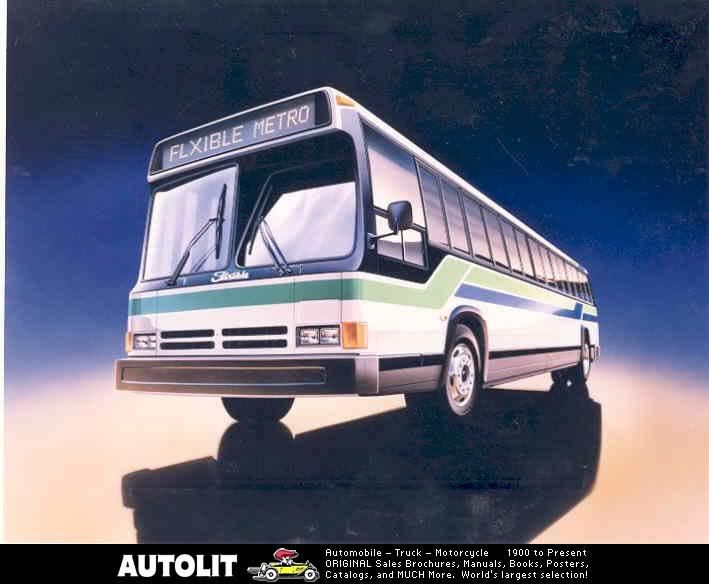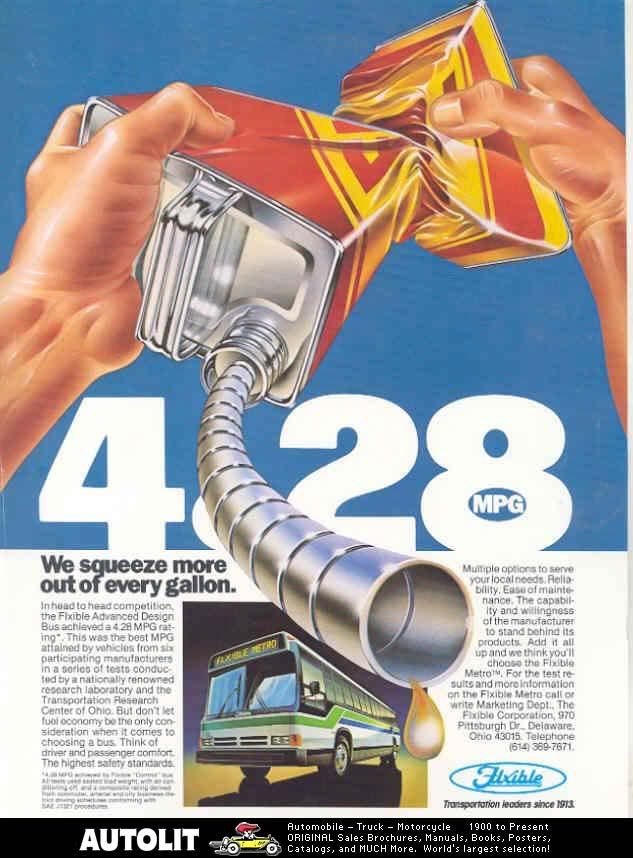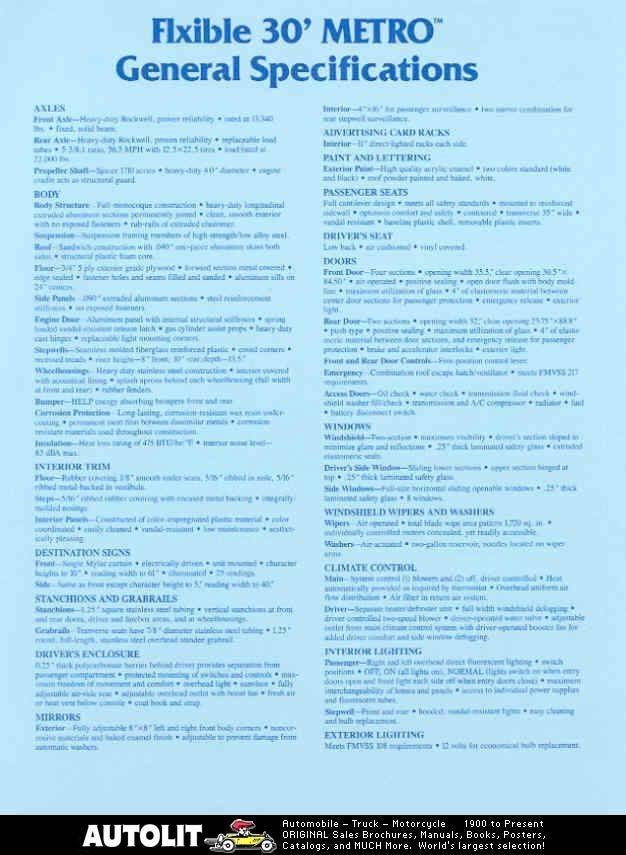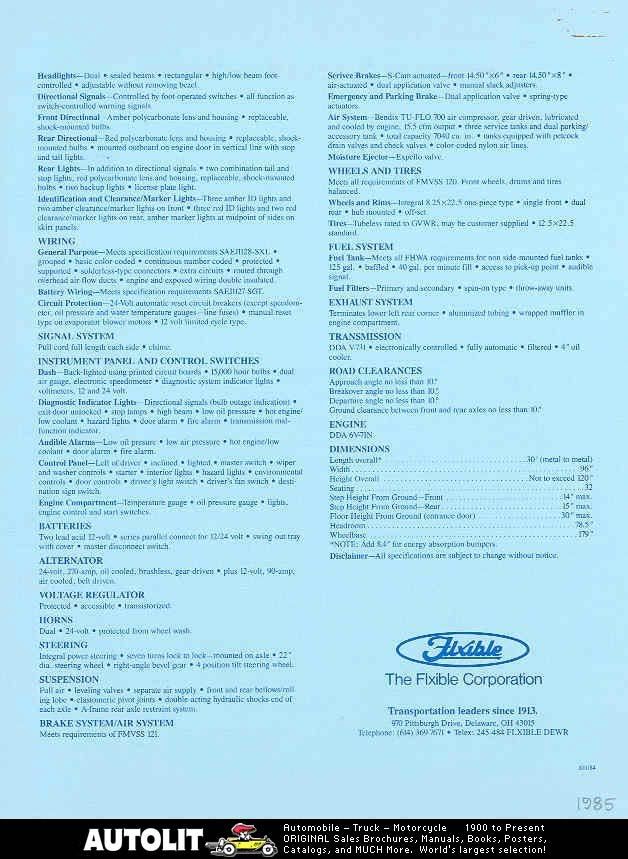 |
BusTalk
A Community Discussing Buses and Bus Operations Worldwide!
|
| View previous topic :: View next topic |
| Author |
Message |
Q65A
Age: 66
Joined: 17 Apr 2007
Posts: 1768
Location: Central NJ
|
 Posted: Mon May 07, 2007 7:06 pm Post subject: Flxible Metro Info Posted: Mon May 07, 2007 7:06 pm Post subject: Flxible Metro Info |
 |
|
I had obtained the following info on-line, possibly at BTN, but I cannot remember where or from whom:
870 Series:
First of the design; incorporating frameless passenger windows (except in sliding window situations), drivers window utilzed a "RTS" style openings, grilless front, rear side engine grill is a basic horizontal grill pattern, 78 degree back slope. Interior characteristics are the "Luminator" interior lights, soild type rubber standee grips and interior rear wall is sloped matching the exterior.
METRO A Series:
Still incorporating frameless passenger windows (except in sliding window situations) & drivers window utilzed a "RTS" style openings. Four part grill introduced on the front, rear side engine grill is changed to a Cris-Crossed pattern. 78 degree back slope remains. Interior characteristics are the "Luminator" interior lights are lost for what we now know as the Transmatic Light System, soild type rubber standee grips are lost for stainless steel standee grips. Interior rear wall is sloped matching the exterior.
METRO B Series:
Still incorporating frameless passenger windows (except in sliding window situations). Drivers window is changed to a "T" style with a larger opening for the driver. 78 degree back slope remains. Interior characteristics are basically the same as the "A", EXCEPT that towards the design change the "C", the rear wall became a straight 90 degree wall.
METRO C Series:
Still incorporating frameless passenger windows (except in sliding window situations) & "B" Style Drivers. 78 degree back slope remains. Interior characteristics are basically the same as the Later version "B" with the straight 90 degree wall. Introduction of the use of Roof Mount HVAC Units comes with this model
METRO D Series:
Introduction of "RTS" type framed windows. Driver's window retains the "T" style however the top portion which was a window is now lost and the Circuit Breaker panel is put in its place, from the exterior however it looks like nothing has changed. 78 degree back slope is lost for a slight reverse 95 degree angle, however later in the design it became a even 90 Degrees. Interior characteristics are basically the same as the "C". HVAC units are on the rooves of this series.
METRO E Series:
Passenger and Driver's Window is that of the "D". 90 Degree exterior back. Interior characteristics are basically the same as the "D", However with the loss of the choice of Roof Mount HVACs, the rear wall gained a new HVAC vent style, taking up a good portion of the rear wall.
METRO A (1983-1987):
Your basic METRO design, very similar to the Bs however retained the 870 style operators window.
METRO B (1987-1991):
Again take your average METRO design, slanted rear exterior. However around 1989 they began offering a 90 degree interior wall to adapt to a change in a Carrier HVAC design. Also the newer Bigger Sliding Operators window began use.
METRO C (1992 ONLY):
METRO B like EXCEPT, the use of roof mount HVAC started as per customer request. The use of the thicker framed Excel Windows began and also the use of the newer driver's stanchion/partion and the loss of the driver's platform began. Also new ergonomic side drivers control panel began use.
METRO D (Late 1992-1994):
Start of the newer 90 Degree Rear Bulkhead, lengthening of driver's area, more use of the roof monuted HVAC system even though the rear mount was still offered. Newer back door glass which was more streamlined with the base of the Excel Windows.
METRO E (1995-End Of Production):
Twin to the METRO D except no use of Roof Mounted HVACs.
1978-Early 1983 was the Grumman Flxible "870" Series
Early 1983-Early 1987 was the Flxible METRO "A" Series
Early 1987-Early 1992 was the Flxible METRO "B" Series
Early 1992-Early 1993 was the Flxible METRO "C" Series
Early 1993-Early 1995 was the Flxible METRO "D" Series
Early 1995-Closing was the Flxible METRO "E" Series
At the time of the closing, Flxible Corp was working on a new lower floor bus called the "Customer Satisfaction" Bus, respecfully the METRO "F". It has been rumored that MCI is continuing the design on this bus and is currently testing a completed model in Mexico.
The letter designation is not the "REAL" model name, it's used by different transit properties to be able to tell the changes in the model as the years progressed.
The real model designations were........
870 Series:
Model 53102-6-1 is the 40 foot/102 wide "870" model with a 6 Cylinder Engine
Model 53102-8-1 is the 40 foot/102 wide "870" model with a 8 Cylinder Engine
Model 53096-6-1 is the 40 foot/96 wide "870" model with a 6 Cylinder Engine
Model 53096-8-1 is the 40 foot/96 wide "870" model with a 8 Cylinder Engine
Model 45102-6-1 is the 35 foot/102 wide "870" model with a 6 Cylinder Engine
Model 45102-8-1 is the 35 foot/102 wide "870" model with a 8 Cylinder Engine
Model 45096-6-1 is the 35 foot/96 wide "870" model with a 6 Cylinder Engine
Model 45096-8-1 is the 35 foot/96 wide "870" model with a 8 Cylinder Engine
In April of 1980 the models changed, wherein the first two numbers in the model no longer represented the passenger amount but changed to the length of the bus. Respectively, 40102-6-1; 35102-6-1 and so forth.
________
METRO Series:
Model 30096-30102 is the 30 foot model, either 96 or 102 wide
Model 35096-35102 is the 35 foot model, either 96 or 102 wide
Model 40096-40102 is the 400 foot model, either 96 or 102 wide
now just like the 870 series these models also had end number to represent the engine in the bus.....
adding -6T means a Detroit Diesel Series 92 (6V92) is being used
adding -6N means a Detroit Diesel Series 71 (6L71N) is being used
adding -6C means a Cummins L10 or M11E is being used
adding -4D means a Detroit Deisel Series 50 is being used
adding -6C8 menas a Cummins C8.3 is being used
adding -6M means a Cummins M11E is being used |
|
| Back to top |
|
 |
ripta42
Site Admin
Age: 45
Joined: 15 Apr 2007
Posts: 1035
Location: Pawtucket, RI / Woburn, MA
|
|
| Back to top |
|
 |
Q65A
Age: 66
Joined: 17 Apr 2007
Posts: 1768
Location: Central NJ
|
 Posted: Tue May 08, 2007 6:51 pm Post subject: Posted: Tue May 08, 2007 6:51 pm Post subject: |
 |
|
| Thanks for refreshing my memory! Trevor Logan and Carlton Walton together have a lot of deep bus knowledge between them, and I always enjoyed their photos and commentary. I found the Flx article to be useful to me when observing Metros at work here in NJ. While Nova RTS06's are most common in my area, once in a while I'll spot an old Metro in the bus lanes at Metropark Train Station. |
|
| Back to top |
|
 |
RTS_04
Joined: 26 Apr 2007
Posts: 66
|
 Posted: Mon May 14, 2007 10:05 am Post subject: Posted: Mon May 14, 2007 10:05 am Post subject: |
 |
|
Can anyone pinpoint when, exactly, did 870s/METROs start offering wheelchair lifts?
Were they always mounted in the entrance doorway/vestibule, or was there a time when they were offered in the rear?
I'm not a huge fan of Flxibles but I am somewhat impressed that they offered a slightly lower floor and easier lift than most RTS'. |
|
| Back to top |
|
 |
KCRam3500

Joined: 16 Apr 2007
Posts: 32
Location: Lake Hopatcong NJ
|
 Posted: Tue May 15, 2007 8:59 pm Post subject: Posted: Tue May 15, 2007 8:59 pm Post subject: |
 |
|
Just as with the RTS, the 870 was offered with wheelchair lifts from day one. The CT Transit Flx 870s built in 1978 (on the line along with the MARTA delivery) had lifts.
They were always in the front door - the rear door was not wide enough.
The lower floor was the reason the bus was built on an angle. The floor was flat, but the front steps were only 8 inches high each, compared to the 10 inches at the rear door. Thus in order for the front step to be lower to the ground, the bus had a very pronounced downward-towards-the-front rake. If the body was level, the front ground-to-step height would have been 4 inches higher than the back door - instead, it was 2 inches lower... meaning the bus had a drop of 6 inches rear-to-front. |
|
| Back to top |
|
 |
RTS_04
Joined: 26 Apr 2007
Posts: 66
|
 Posted: Fri Nov 30, 2007 9:00 pm Post subject: Posted: Fri Nov 30, 2007 9:00 pm Post subject: |
 |
|
Not to beat a dead horse, here, but I've another Flx question...
I notice this in the write-up...
"METRO B ... also the use of the newer driver's stanchion/partion and the loss of the driver's platform began. Also new ergonomic side drivers control panel began use. "
I've noticed how early 870s/ Metros had that odd "hanging-basket" driver platform, and I'm guessing this is what they're referring to.
But does anyone know why this changed? |
|
| Back to top |
|
 |
Q65A
Age: 66
Joined: 17 Apr 2007
Posts: 1768
Location: Central NJ
|
|
| Back to top |
|
 |
Q65A
Age: 66
Joined: 17 Apr 2007
Posts: 1768
Location: Central NJ
|
 Posted: Sat Dec 01, 2007 6:18 pm Post subject: Posted: Sat Dec 01, 2007 6:18 pm Post subject: |
 |
|
Here's another shot of a Metro operator's compartment from Oren's Transit Page, this time from an older WMATA Flx Metro:
http://www.orenstransitpage.com/otpdccars/metrobint3.jpg
Note that the LH side panels differ from the older and newer Metros.
The newer Metro also has the parking brake valve mounted below the LH side of the front dashboard, right above the B/O's left knee (same location as on MCI J units) while older Metros and 870's had parking brake valves mounted immediately to the right of the B/O's seat. |
|
| Back to top |
|
 |
RTS_04
Joined: 26 Apr 2007
Posts: 66
|
 Posted: Sat Dec 01, 2007 8:26 pm Post subject: Posted: Sat Dec 01, 2007 8:26 pm Post subject: |
 |
|
I knew about the changes to the side panel, but there's also something different between the operator platforms themselves.
On 870s (and early Metros, I believe), the operator sits on a "floating platform". What the driver's feet rest on is actually a perforated false floor that's about 4-6" above the actual coach floor, and I believe it hangs from the ceiling.
Later Metros didn't have this - the operator's feet rested on a solid platform (level with the front floor, IIRC) while the seat was mounted on top of a rectangular drawer.
If I had a slide scanner, I'd have some great examples (shot an ex-NYCTA 870 at Cincinnati, an early Metro A/B at TANK and a later Metro B/C in Dayton during the last MBS trip), but I don't. Does anyone know what I'm talking about - and if so, have any reason for the change? |
|
| Back to top |
|
 |
Q65A
Age: 66
Joined: 17 Apr 2007
Posts: 1768
Location: Central NJ
|
 Posted: Mon Dec 03, 2007 9:11 pm Post subject: Posted: Mon Dec 03, 2007 9:11 pm Post subject: |
 |
|
I definitely can envision what you're saying about that strange expanded metal "floating plaform" design.
I don't know the exact, official reason for the change-over (Ebert does not mention it in his Flxible history, nor did McKane in his book "Flxible Transit Buses 1953-1995 Photo Archive) but I would guess that the industry-standard raised operator platform would have been easier and cheaper to build. Additionally, I would think that the original floating platform would have been very tough on bus cleaners when they needed to sweep debris from beneath the B/O compartment. |
|
| Back to top |
|
 |
KCRam3500

Joined: 16 Apr 2007
Posts: 32
Location: Lake Hopatcong NJ
|
 Posted: Wed Dec 05, 2007 1:27 pm Post subject: Posted: Wed Dec 05, 2007 1:27 pm Post subject: |
 |
|
The original driver's area was done that way because of how the bus was built... the seats and such were mounted to the sidewalls and the driver's seat needed a mount of another type because it wasn't close enough to the side. The elevated steel grated floor was mounted to the sidewall and the driver's seat mounted to that. The grate was marketed by Flxible as a way to "keep the driver's feet dry in inclement weather" (from the 870 sales catalog), meaning the driver's shoes wouldn't be sitting in any water (rain, melted snow).
The change was made because the new ergonomic driver seats (e.g. Recaro) would have been a more difficult mount in the original design. Operators requested a standardized mounting to make maintenance easier for mixed fleets. This was the same reason Flx dropped their unique passenger seats and went to the usual American Seating products with pedestals. |
|
| Back to top |
|
 |
Q65A
Age: 66
Joined: 17 Apr 2007
Posts: 1768
Location: Central NJ
|
 Posted: Wed Dec 05, 2007 9:59 pm Post subject: Posted: Wed Dec 05, 2007 9:59 pm Post subject: |
 |
|
| Interesting information; thanks for the details!!! |
|
| Back to top |
|
 |
Mr. Linsky
BusTalk's Offical Welcoming Committee

Joined: 16 Apr 2007
Posts: 5071
Location: BRENTWOOD, CA. - WOODMERE, N.Y.
|
 Posted: Fri Jan 04, 2008 3:41 am Post subject: Posted: Fri Jan 04, 2008 3:41 am Post subject: |
 |
|
Being that it's so quiet on the set (so to speak), I thought I'd throw in a couple of interesting Flexible Metro ads to illustrate what you're all talking about here.
They were really great looking buses!
Mr. Linsky - Green Bus Lines, Inc., Jamaica, NY



 |
|
| Back to top |
|
 |
Q65A
Age: 66
Joined: 17 Apr 2007
Posts: 1768
Location: Central NJ
|
 Posted: Fri Jan 04, 2008 8:15 pm Post subject: Posted: Fri Jan 04, 2008 8:15 pm Post subject: |
 |
|
Happy New Year, Mr. L!
This is a very nice post, indeed.
I have always liked the looks of the Flx 870 and Metro.
In my opinion, NJT's Flx Metro-D's have a rather "macho", business-like look about them, with that LH slanting windshield and that boxy rooftop Sutrak HVAC housing.
In contrast, the NJT Nova RTS06's appear sleeker and more streamlined. |
|
| Back to top |
|
 |
|
|
You cannot post new topics in this forum
You cannot reply to topics in this forum
You cannot edit your posts in this forum
You cannot delete your posts in this forum
You cannot vote in polls in this forum
You can attach files in this forum
You can download files in this forum
|
Powered by phpBB © 2001, 2005 phpBB Group
|






